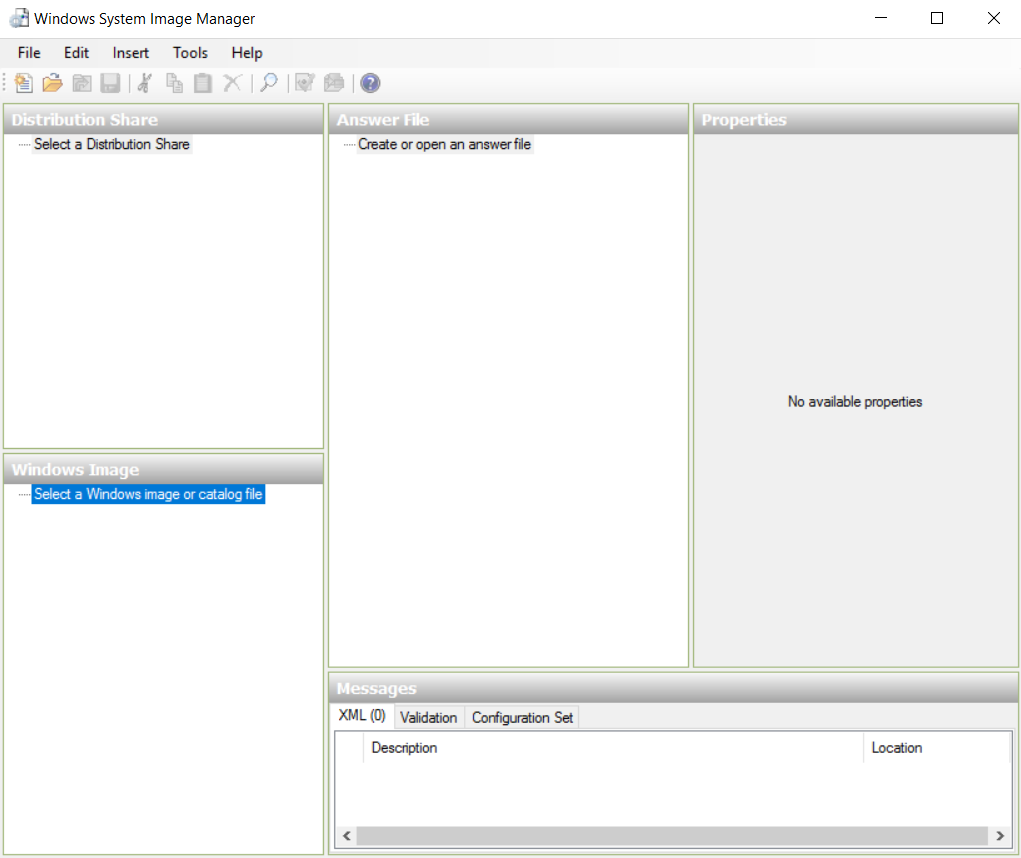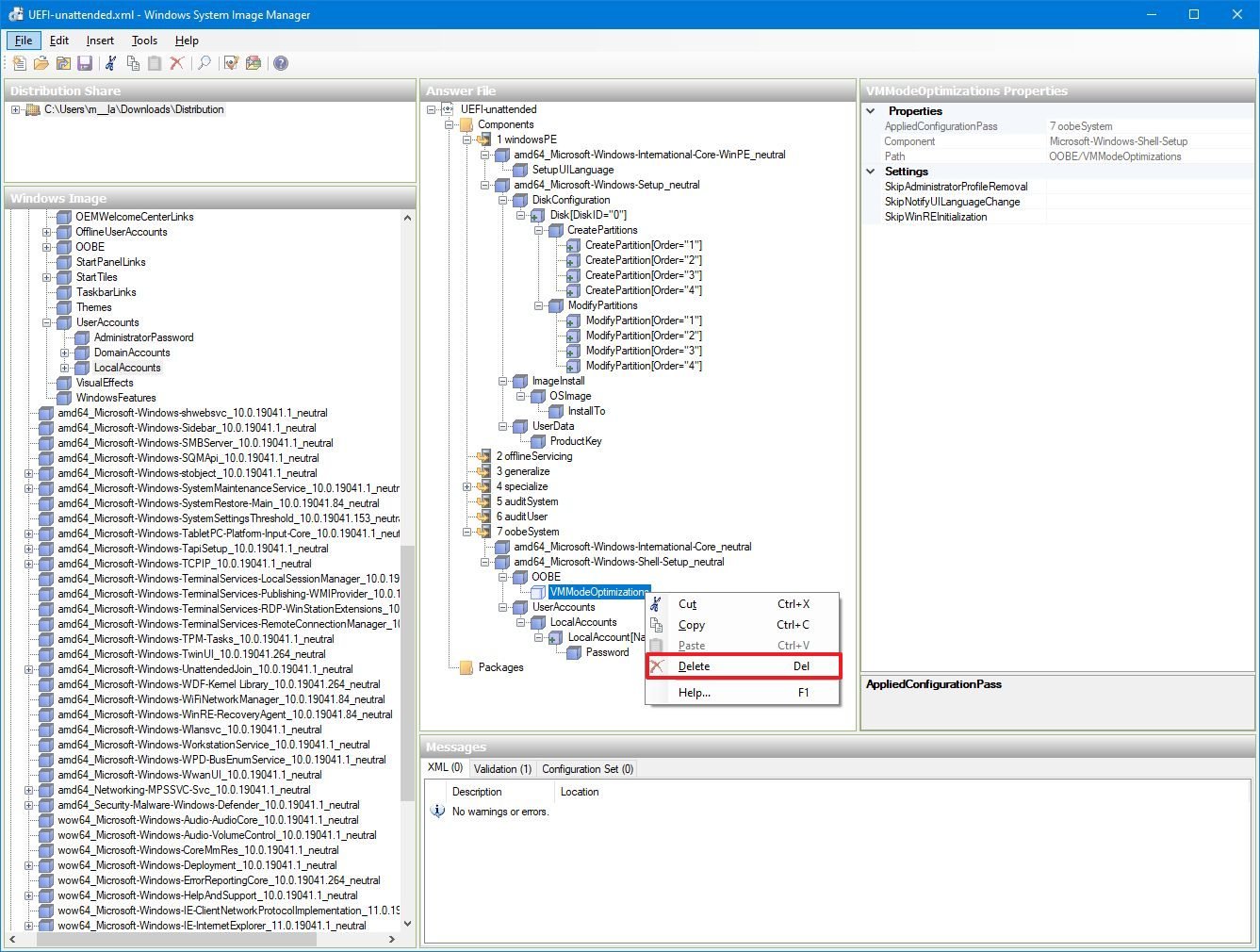-->
Answer files (or Unattend files) can be used to modify Windows settings in your images during Setup. You can also create settings that trigger scripts in your images that run after the first user creates their account and picks their default language.

Unattended Windows 98 installation using answer file In this video tutorial I walk you through creating an answer file, the core of an unattended installation. I install Windows 98 all the time, basically for every project I'm starting new. Where is the unattend file stored after you install Windows?Helpful? Please support me on Patreon: thanks & praise.
Windows Setup will automatically search for answer files in certain locations, or you can specify an unattend file to use by using the /unattend: option when running Windows Setup (setup.exe).
Windows settings overview
While you can set many Windows settings in audit mode, some settings can only be set by using an answer file or Windows Configuration Designer, such as adding manufacturer’s support information. A full list of answer file settings (also known as Unattend settings) is in the Unattended Windows Setup Reference.
Enterprises can control other settings by using Group Policy. For more info, see Group Policy.
Answer file settings
You can specify which configuration pass to add new settings:
1 windowsPE: These settings are used by the Windows Setup installation program. If you’re modifying existing images, you can usually ignore these settings.
4 specialize: Most settings should be added here. These settings are triggered both at the beginning of audit mode and at the beginning of OOBE. If you need to make multiple updates or test settings, generalize the device again and add another batch of settings in the Specialize Configuration pass.
6 auditUser: Runs as soon as you start audit mode.
This is a great time to run a system test script - we'll add Microsoft-Windows-DeploymentRunAsynchronousCommand as our example. To learn more, see Add a Custom Script to Windows Setup.
7 oobeSystem: Use sparingly. Most of these settings run after the user completes OOBE. The exception is the Microsoft-Windows-DeploymentResealMode = Audit setting, which we’ll use to bypass OOBE and boot the PC into audit mode.
If your script relies on knowing which language the user selects during OOBE, you’d add it to the oobeSystem pass.
To learn more, see Windows Setup Configuration Passes.
Note
These settings could be lost if the user resets their PC with the built-in recovery tools. To see how to make sure these settings stay on the device during a reset, see Sample scripts: Keeping Windows settings through a recovery.
Create and modify an answer file
Step 1: Create a catalog file
Start Windows System Image Manager.
Click File > Select Windows Image.
In Select a Windows Image, browse to and select the image file (D:install.wim). Next, select an edition of Windows, for example, Windows 10 Pro, and click OK. Click Yes to create the catalog file. Windows SIM creates the file based on the image file, and saves it to the same folder as the image file. This process can take several minutes.
The catalog file appears in the Windows Image pane. Windows SIM lists the configurable components and packages in that image.
Troubleshooting: If Windows SIM does not create the catalog file, try the following steps:
To create a catalog file for either 32-bit or ARM-based devices, use a 32-bit device.
Make sure the Windows base-image file (SourcesInstall.wim) is in a folder that has read-write privileges, such as a USB flash drive or on your hard drive.
Step 2: Create an answer file
Click File > New Answer File.
The new answer file appears in the Answer File pane.
Note If you open an existing answer file, you might be prompted to associate the answer file with the image. Click Yes.
Step 3: Add new answer file settings
Add OEM info:
In the Windows Image pane, expand Components, right-click amd64_Microsoft-Windows-Shell-Setup_(version), and then select Add Setting to Pass 4 specialize.
In the Answer File pane, select Components4 specializeamd64_Microsoft-Windows-Shell-Setup_neutralOEMInformation.
In the OEMInformation Properties pane, in the Settings section, select:
- Manufacturer=
Fabrikam - Model=
Notebook Model 1 - Logo=
C:FabrikamFabrikam.bmp
Create a 32-bit color with a maximum size of 120x120 pixels, save it as
D:AnswerFilesFabrikam.bmpfile on your local PC, or use the sample from the USB-B key:D:ConfigSet$OEM$$$System32OEMFabrikam.bmp.We'll copy the logo into the Windows image in a few steps.
- Manufacturer=
Set the device to automatically boot to audit mode:
In the Windows Image pane, expand Components, right-click amd64_Microsoft-Windows-Deployment_(version), and then select Add Setting to Pass 7 oobeSystem.
In the Answer File pane, select Components7 oobeSystemamd64_Microsoft-Windows-Deployment_neutralReseal.
In the Reseal Properties pane, in the Settings section, select Mode=
Audit.Prepare a script to run after Audit mode begins.
In the Windows Image pane, right-click amd64_ Microsoft-Windows-Deployment_(version) and then click Add Setting to Pass 6 auditUser.
In the Answer File pane, expand Components6 auditUseramd64_Microsoft-Windows-Deployment_neutralRunAsynchronous. Right-click RunAsynchronousCommand Properties and click Insert New AsynchronousCommand.
In the AsynchronousCommand Properties pane, in the Settings section, add the following values:
Path = C:FabrikamSampleCommand.cmdDescription = Sample command to run a system diagnostic check.Order = 1(Determines the order that commands are run, starting with 1.)Add a registry key. In this example, we add keys for the OEM Windows Store program. Use the same process as adding a script, using
CMD /c REG ADD.For Windows 10 Customer Systems, you may use the OEM Store ID alone or in combination with a Store Content Modifier (SCM) to identify an OEM brand for the OEM Store. By adding a SCM, you can target Customer Systems at a more granular level. For example, you may choose to target commercial devices separately from consumer devices by inserting unique SCMs for consumer and commercial brands into those devices.
Add RunAsynchronousCommands for each registry key to add. (Right-click RunAsynchronousCommand Properties and click Insert New AsynchronousCommand).
See the Unattended Windows Setup Reference for a full list of configuration options.

Step 4: Save the answer file
Save the answer file, for example: D:AnswerFilesBootToAudit-x64.xml.
Note Windows SIM will not allow you to save the answer file into the mounted image folders. Step 5: Create a script
Since we specified a script to run in Step 3, let's create that script now.
Copy the following sample script into Notepad, and save it as D:AnswerFilesSampleCommand.cmd.
Add the answer file and script to the image
Step 6: Mount an image and add the answer file
Use DISM to mount a Windows image. To learn how to mount an image, see Mount and modify a Windows image using DISM
Copy the answer file into the image into the WindowsPanther folder, and name it unattend.xml. The Panther folder is one of the folders where Windows searches for an answer file. Create the folder if it doesn’t exist. If there’s an existing answer file, replace it or use Windows System Image Manager to edit/combine settings if necessary.
Unmount the image, committing the changes. For example:
where C is the drive letter of the drive that contains the mounted image.
This process may take several minutes.
When you apply your image, Windows will process your unattend file and will configure your settings based on what you specified in the unattend.
Windows Answer File Generator (WAFG) is a simple website that provides similar functions to Windows System Image Manager (SIM).
Windows System Image Manager is the tool used to create an unattended Windows Setup answer file. Windows AFG, however, does not need the Windows Automated Installation Kit or Windows Assessment and Deployment Kit to be installed or downloaded. Windows AFG provides a simple web based form that gives the user options to configure the desired answer file; which is all based off Windows SIM.
This website will allow you to configure numerous settings that are necessary for the Windows Setup process. Some of the configuration settings include:
- General Installation settings
- Regional configuration
- Out Of Box Experience settings
- Windows Update settings
- Partition creation
- User Account information

Windows AFG has one simple form to create an unattended answer file for the x86 and x64 bit architectures.
All major editions of Windows 7 are supported, which include:
- Windows 7 Starter
- Windows 7 Home Basic
- Windows 7 Home Premium
- Windows 7 Professional
- Windows 7 Ultimate
- Windows 7 Enterprise
All major editions of Windows 8 are supported, which include:
- Windows 8
- Windows 8 Pro
- Windows 8 Pro with Media Center
- Windows 8 Enterprise
All major editions of Windows 8.1 are supported, which include:
- Windows 8.1
- Windows 8.1 Pro
- Windows 8.1 Pro with Media Center
- Windows 8.1 Enterprise
All major editions of Windows 10 are supported, which include:
- Windows 10 Home
- Windows 10 Pro
- Windows 10 Education
- Windows 10 Enterprise
- Windows 10 Enterprise LTSB
All major editions of Windows Server 2008 and Server 2008 R2 are supported, which include:
- Windows Server 2008/R2 Foundation
- Windows Server 2008/R2 Storage Server
- Windows Server 2008/R2 Web Server
- Windows Server 2008/R2 Standard
- Windows Server 2008/R2 Enterprise
- Windows Server 2008/R2 Datacenter
- Windows Server 2008/R2 HPC
- Windows Server 2008/R2 Itanium
All major editions of Windows Server 2012 are supported, which include:
- Windows Server 2012/R2 Foundation
- Windows Server 2012/R2 Essentials
- Windows Server 2012/R2 Standard
- Windows Server 2012/R2 Datacenter
All major editions of Windows Server 2016 are supported, which include:
- Windows Server 2016 Essentials
- Windows Server 2016 Standard
- Windows Server 2016 Datacenter
All major editions of Windows Server 2019 are supported, which include:
- Windows Server 2019 Standard
- Windows Server 2019 Datacenter

Sub versions of Windows Server 2008 and Server 2008 R2 are supported, which include:
- Windows Small Business Server 2008
- Windows Small Business Server 2011
Windows Unattend File Generator
Windows 8.1 Unattend File
Windows AFG also supports Windows 7 images that have the 'ei.cfg' removed. When using an installation that has the 'ei.cfg' removed, you will be prompted to select the Windows edition before the unattended installation beings.
This form based tool can be used by anyone; from individuals who install Windows 7 for friends or family, all the way up to enterprise IT personnel. This can be used in conjunction with disk cloning and Sysprep for desktop deployment.
Windows Unattend File Manager
If you find this website or its content useful and you wish to make a donation, please feel free by clicking the button below. Any donations received will be much appreciated with keeping this website operational, maintaining hardware/software, providing code updates and adding extra features.
Don't forget to follow us on Facebook.